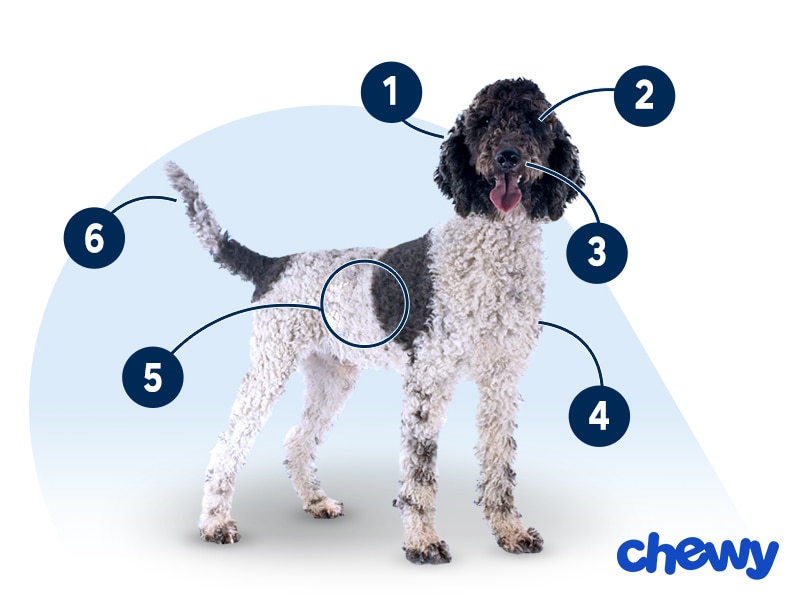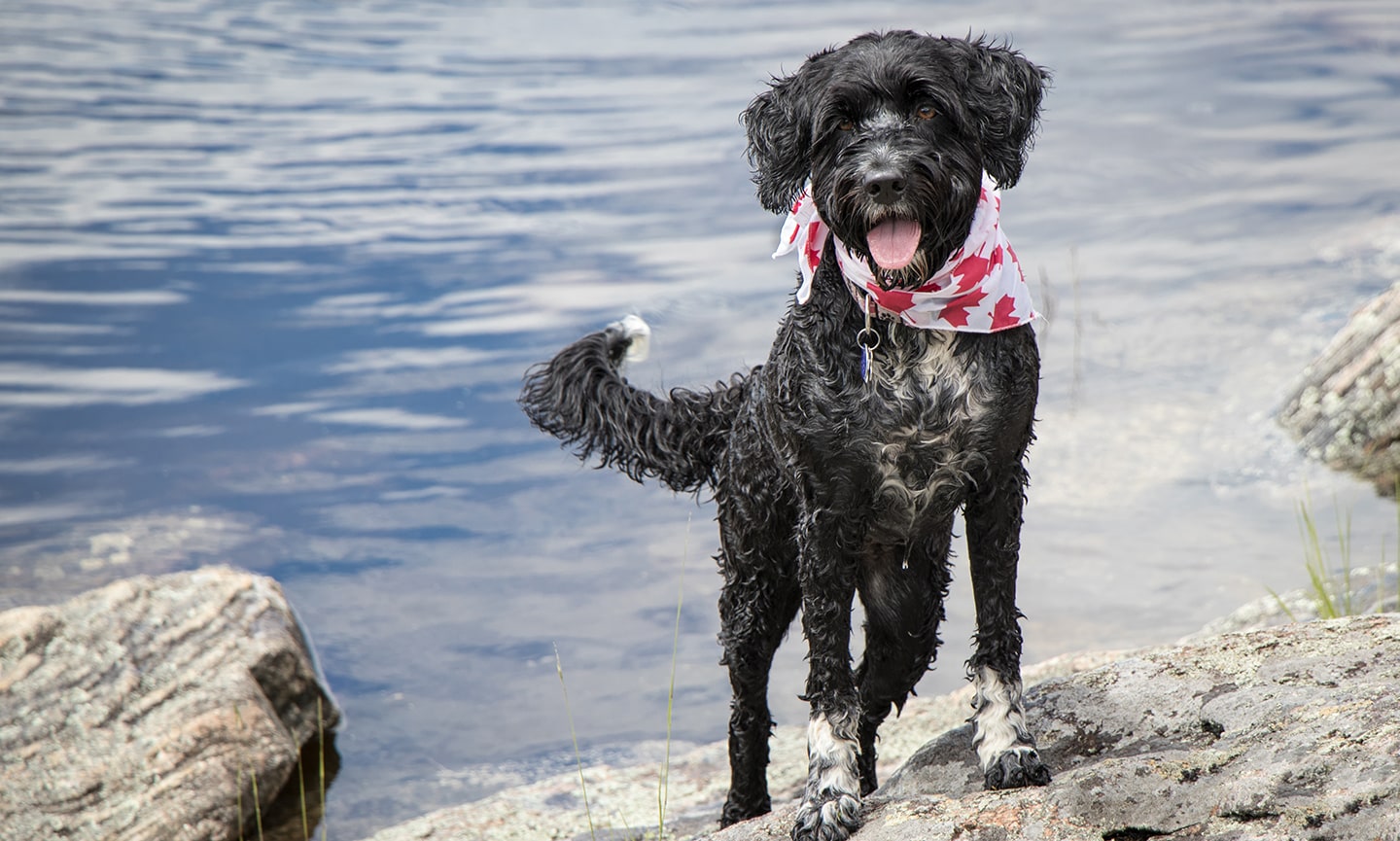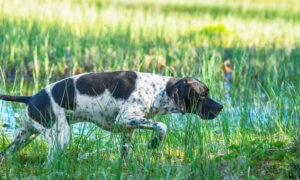Portuguese Water Dog
Updated December 15, 2025
Portuguese Water Dog
Updated December 15, 2025
The Portuguese Water Dog is a dynamic and exceptionally smart pup who loves the great outdoors. A natural people pleaser, they’ll be happy to enjoy life beside kids, dogs, and maybe even cats. True to their name, these dogs love water, so prepare for lots of poolside adventures once summer rolls around.
Active, Fun-Loving, Intelligent
35–60 pounds
17–23 inches
11–13 years
Black, White, Brown
In another life, the Portuguese Water Dog might have been a mermaid. These affable canines adore the ocean (or any water, really) and, if you let them, they’d spend their life splashing in the waves.
But, as their luck would have it, these water-loving dogs are destined for life on land. Ease their troubles by making sure they have access to a gloriously sandy beach (or a backyard kiddie pool). If you can offer activities like dock diving, too, they’ll be happy as a clam.
Either way, Portuguese Water Dogs are cheery, easygoing canines who need a pet parent who’s active and excited to be part of their world.
Portuguese Water Dog Characteristics
Portuguese Water Dog Appearance
The Portuguese Water Dog has dark eyes and an attentive expression. Strong swimmers (with webbed paws, no less), they use their long tail as a rudder in the water to navigate where they’re going.
Their fuzzy fur—curly or wavy—is usually black, white, brown, or a combination of two colors.

- Ears
The heart-shaped ears of the Portuguese Water Dog are usually covered in wavy hair, hanging down on the sides and framing their inquisitive face.
- Eyes
Their medium-sized, roundish eyes are various shades of brown and have an alert and attentive expression.
- Nose
Portuguese Water Dogs typically have broad nostrils; their nose is black in black dogs or various shades of brown in those with brown coats.
- Coat Length
Some have compact, cylindrical curls, while others have fur that falls in gentle waves.
- Coat Color
Portuguese Water Dog colors include black, white, various shades of brown, and combinations of black or brown with white.
- Tail
The Portuguese Water Dog has a long, low-hanging tail.
Portuguese Water Dog Temperament
You don’t need a boat to befriend a Portuguese Water Dog, but it helps. They’re not exactly trying to make “water” their whole personality, but they’re really into pools, lakes, oceans—you name it.
Portuguese Water Dogs are also friendly dogs and loyal to their families, with a gentle, easygoing vibe that also tends to be playful.
The Portuguese Water Dog temperament truly is so clever and energetic that they need a pet parent who can give them an active lifestyle that’s also mentally challenging. These dogs don’t enjoy being bored, and they want someone who can keep them company.
As independent-minded and active dogs, they’ll impress you with their athleticism (even when you’re tired of throwing the ball—sorry, keep going, they’re loving it!).
How to Care for a Portuguese Water Dog
The Portuguese Water Dog is a low–shedding dog breed, but that doesn’t mean they’re low–maintenance. They require regular grooming and plenty of intellectually stimulating activities to keep them happy and healthy.
Grooming
Training
Diet
Exercise
Environment
Portuguese Water Dog Health
The average Portuguese Water Dog lifespan is 11–13 years. Here are some health issues to be aware of.
- Cataracts: Cataracts aren’t usually painful, but they can cause cloudy eyes and vision loss, so get a yearly eye test to catch them early. Surgery is the go-to treatment.
- Dilated cardiomyopathy: Dilated cardiomyopathy is a genetic condition where the heart enlarges and does not work properly, possibly resulting in heart failure. Diagnosis is based on an echocardiogram and treatment is often daily medication.
- GM1 gangliosidosis: This congenital disorder is, unfortunately, fatal. It progressively destroys nerve cells in the brain and spinal cord; signs may include tremors, seizures, and vision loss in puppies around 6 months old. See a vet immediately if you suspect an issue.
- Hip dysplasia: Hip dysplasia is when the ball and socket of the hip and thigh bones doesn’t properly fit, leading to a looser joint and, eventually, arthritis and pain. More severe cases may require surgery, but the condition is often treated with medications, joint supplements, special diets, weight management, and/or physical therapy.
- Progressive retinal atrophy (PRA): PRA leads to blindness in dogs. There’s no cure, but pups who lose their eyesight tend to adapt well and can still live full, happy lives.
Portuguese Water Dog History
The Portuguese Water Dog hails from (surprise!) Portugal.
Evidence suggests they were roaming Iberian beaches in 1297, at the very latest, but they likely appeared centuries earlier in their role as fishermen’s BFFs. They fearlessly dove into the sea to herd fish and retrieve nets and tackle, according to the Portuguese Water Dog Club of America.
These dogs even escorted Portuguese fishermen on their boats, making the long and arduous journey from the Atlantic waters of their homeland to the coast of Iceland for work. When technological advances made their job obsolete, they became family dogs.
Sadly, the dogs almost became extinct in the 1930s, but some fans took it upon themselves to see the breed was revived, and the Portuguese Water Dog Club of America was established in 1972. By 1983, they were recognized by the American Kennel Club.
Senator Ted Kennedy gifted Bo, a Portuguese Water Dog, to President Barack Obama in 2009, and the Obama family loved Bo so much that they added Sunny to the White House in 2013. This formerly rare dog breed has been growing in popularity ever since.
The typical Portuguese Water Dog price tends to be between $1,500–$2,500. If you choose this route, pick a responsible breeder.
You can also consider Portuguese Water Dog adoption. Search for Portuguese Water Dog rescues via the PWDCA’s rescue arm, ask about the breed at your local animal shelter, or search Chewy’s database of adoptable dogs in your area.








